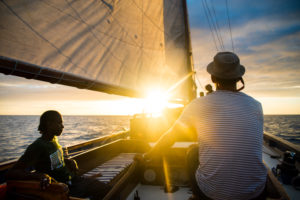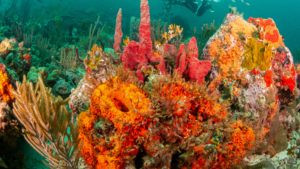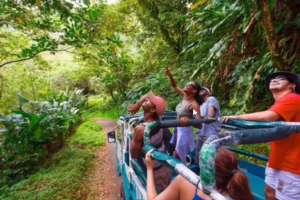Room to Explore
 The main island of Grenada is rich in both natural beauty and history, with petroglyphs at Duquesne Bay dating back to the time of the Arawak people. French and English forts as well as great houses stand as reminders of the centuries-long struggle by European powers to control the island. At just 133 square miles in size, Grenada is small enough to explore at one’s leisure yet rich in diverse activities for visitors, who can spend a morning on the beach, hike to a waterfall in the rainforest in the afternoon, and still be back in time for dinner at their resort and enjoy the nightlife in St. George’s.
The main island of Grenada is rich in both natural beauty and history, with petroglyphs at Duquesne Bay dating back to the time of the Arawak people. French and English forts as well as great houses stand as reminders of the centuries-long struggle by European powers to control the island. At just 133 square miles in size, Grenada is small enough to explore at one’s leisure yet rich in diverse activities for visitors, who can spend a morning on the beach, hike to a waterfall in the rainforest in the afternoon, and still be back in time for dinner at their resort and enjoy the nightlife in St. George’s.
Carriacou, the “Island of Reefs,” retains the slow pace of life sought by generations of Caribbean travelers. Smaller than the island of Grenada and inhabited by just 8,000 people, Carriacou is infused with a fascinating mix of African and Scottish culture that includes deep traditions around string band music, big drum dancing and boat-building—all just a 90-minute ferry ride away or 20 minutes via plane.

Nearby Petite Martinique is only accessible by boat and is cherished for its fishing, peaceful leeward-side beaches and its annual Petite Martinique Whitsuntide Regatta, one of the top sailing events in the Caribbean.
Top activities in Grenada include:
 Sailing: Grenada is one of the top yachting destinations in the world and is great to experience by sea as well as a great base to explore the 32 islands of the Grenadines from Carriacou and Petite Martinique in the south. There are a number of yacht charter companies that can put clients on a stocked, crewed or bareback sailboat or catamaran to explore the islands.
Sailing: Grenada is one of the top yachting destinations in the world and is great to experience by sea as well as a great base to explore the 32 islands of the Grenadines from Carriacou and Petite Martinique in the south. There are a number of yacht charter companies that can put clients on a stocked, crewed or bareback sailboat or catamaran to explore the islands.
Additionally, there are a variety of companies that offer day cruises to remote beaches and snorkeling spots as well as sunset party cruises with live music, DJs, dancing and free-flowing rum punch.
Close to the Underwater Sculpture Park created by artist Jason deCaires Taylor is Dragon Bay, a popular stop for yachts and dive boats. Tyrrel Bay on Carriacou is a popular anchorage thanks to its protected location, beautiful beach and welcoming beach bars. For boaters, the charm of Carriacou goes beyond its crystalline waters: The island also has a centuries-old tradition of building wooden boats, carried over by settlers from Scotland and still continued today. A tour of the island is a chance to see sailboats being crafted by hand on local beaches, ready to be pushed out to sea when the work is done.
 Diving: PADI-certified dive shops lead excursions to Grenada and Carriacou’s 50-plus dive sites, including to the largest natural shipwreck in the Caribbean, the Bianca C—a 600-ft. Italian cruise ship that caught fire and sank in 1961—and the recently renovated Underwater Sculpture Park in Molinere Bay. Most dive sites are on the island’s south and west coasts, and while the Bianca C is for advanced divers only, there’s plenty to see and do for novice and intermediate divers too, including drift dives to Purple Rain and Shark Reef. There’s also easy shallow diving in Dragon Bay and exploring the amazing Flamingo Bay, both located in the destination’s Marine Protected Area (MPA). There’s also the opportunity to plunge into the clear waters to explore many colorful reefs teeming with tropical fish. Visitors don’t need to dive to explore the sculpture park, which is clearly visible to snorkelers too; snorkeling is also popular right off the beaches at popular resort areas like Grand Anse and at Morne Rouge beach where the crystal waters and abundant fish life make for great offshore swimming.
Diving: PADI-certified dive shops lead excursions to Grenada and Carriacou’s 50-plus dive sites, including to the largest natural shipwreck in the Caribbean, the Bianca C—a 600-ft. Italian cruise ship that caught fire and sank in 1961—and the recently renovated Underwater Sculpture Park in Molinere Bay. Most dive sites are on the island’s south and west coasts, and while the Bianca C is for advanced divers only, there’s plenty to see and do for novice and intermediate divers too, including drift dives to Purple Rain and Shark Reef. There’s also easy shallow diving in Dragon Bay and exploring the amazing Flamingo Bay, both located in the destination’s Marine Protected Area (MPA). There’s also the opportunity to plunge into the clear waters to explore many colorful reefs teeming with tropical fish. Visitors don’t need to dive to explore the sculpture park, which is clearly visible to snorkelers too; snorkeling is also popular right off the beaches at popular resort areas like Grand Anse and at Morne Rouge beach where the crystal waters and abundant fish life make for great offshore swimming.
Grenada is leading the way with respect to sustainable tourism. For example, Dive Grenada is funding and constructing Grenada’s first unique artificial reef, known as the “Grenada Artificial Reef Pyramids.” Fifty “Pyramids,” easily reached off Grand Anse Beach, are now installed and have proven to be an outstanding success with great biodiversity and biomass.
Known as a year-round diving destination, Grenada & Carriacou really do “Have it All” with respect to their diving product, including short boat trips to the dive sites, typically 15 minutes, and more shipwrecks than any other Caribbean island, including the largest, the Bianca C, known locally as the “Titanic of the Caribbean.”
The unique Underwater Sculpture Park includes the iconic “Vicissitudes (Ring of Children),” was named by National Geographic as one of the “Wonders of the World, Earth’s most awesome places.”
Hiking: You don’t have to hike to get to a waterfall in Grenada—visitors can literally drive right up to Annandale Falls, which has a popular bar and is lit up at night—but Grenada’s 15 waterfalls make a refreshing destination for a variety of rainforest hikes, from easy to exerting. Grand Etang National Park offers the opportunity to meet Mona monkeys and marvel at a “bottomless” lake, while visitors can combine a hike around a coastal pond with beach time at scenic Levera National Park.
Local guides like Simon Greene lead guests on explorations along peaceful footpaths and provide lessons in island history, culture, and flora and fauna along the way. While Telfor Bedeau—known as the, “Indiana Jones of Grenada”—has not only kayaked around the island and walked nearly every inch of it, he’s also climbed the highest peak, Mt. St. Catherine, 217 times.
 Adventures: Adrenaline-pumping activities await on both land and sea in Grenada. Sportfishing charters set course in pursuit of big game fish like marlin, sailfish, tuna and dorado, and visitors can try their hand at sailing on a catamaran day tour. In fact, Grenada plays host to the Grenada Spice Island Billfish Tournament, a qualifying event for the Offshore World Championship that is held annually in January and continues to experience growth from year to year with the tournament’s high conservation standards attracting the attention of internationally renowned companies. It is an internationally recognized tournament with established linkages with the key players in the international bill-fishing community, the International Game Fishing Association (IGFA) and the Billfish Foundation. Participation is garnered from international locations, the US and the UK, and neighboring Caribbean countries. It is the largest billfish tournament in the southern Caribbean, measured by participation of anglers, and has the potential to grow even further. Its advantages include Grenada’s physical location where different types of billfish (three species) are available; the high environmental standards of the tournament highlighted by the use of “tag and release” fishing; the efficient organization of the tournament; and its recognition by the international bill-fishing community. The event was cancelled for 2020 and 2021 due to COVID19 but it is set to be held in 2022 from January 25 to 20 with 23 boats registered with 138 anglers.
Adventures: Adrenaline-pumping activities await on both land and sea in Grenada. Sportfishing charters set course in pursuit of big game fish like marlin, sailfish, tuna and dorado, and visitors can try their hand at sailing on a catamaran day tour. In fact, Grenada plays host to the Grenada Spice Island Billfish Tournament, a qualifying event for the Offshore World Championship that is held annually in January and continues to experience growth from year to year with the tournament’s high conservation standards attracting the attention of internationally renowned companies. It is an internationally recognized tournament with established linkages with the key players in the international bill-fishing community, the International Game Fishing Association (IGFA) and the Billfish Foundation. Participation is garnered from international locations, the US and the UK, and neighboring Caribbean countries. It is the largest billfish tournament in the southern Caribbean, measured by participation of anglers, and has the potential to grow even further. Its advantages include Grenada’s physical location where different types of billfish (three species) are available; the high environmental standards of the tournament highlighted by the use of “tag and release” fishing; the efficient organization of the tournament; and its recognition by the international bill-fishing community. The event was cancelled for 2020 and 2021 due to COVID19 but it is set to be held in 2022 from January 25 to 20 with 23 boats registered with 138 anglers.
 Additionally, a paddle with transparent kayaks provides an unimpaired view of the pristine reef and the sea life below. Hiking isn’t the only way to explore Grenada’s tropical backcountry: Jeep and ATV tours journey through small villages and into the rainforest to discover cultural sites and waterfalls. Meanwhile, river tubing is a great way to experience the rushing river-water and placid pools of the Balthazar River. Joggers can join local “hashing” groups that meet every weekend for runs in different parts of the island, culminating in a classic West Indian party that attracts people from every walk of life.
Additionally, a paddle with transparent kayaks provides an unimpaired view of the pristine reef and the sea life below. Hiking isn’t the only way to explore Grenada’s tropical backcountry: Jeep and ATV tours journey through small villages and into the rainforest to discover cultural sites and waterfalls. Meanwhile, river tubing is a great way to experience the rushing river-water and placid pools of the Balthazar River. Joggers can join local “hashing” groups that meet every weekend for runs in different parts of the island, culminating in a classic West Indian party that attracts people from every walk of life.
Culture: With its blend of African and European influences, Grenada’s culture is expressed through its food, music, dance and arts. The islands of Grenada, Carriacou and Petite Martinique are home to some of the most unique cultural events in the Caribbean. The summer Spicemas, with its carnival parades, Calypso music and oil-drenched J’Ouvert celebration, is the country’s biggest party each August, while the Carriacou Carnival—a Lenten celebration held the Monday and Tuesday before Ash Wednesday—features masked revelers facing off in a form of Shakespearean rap battle. Carriacou has separate festivals dedicated to traditional parang folk music (December) and African maroon culture (late April-early May), the latter highlighted by Big Drum Nation Dances, string bands and smoked foods. Founded in 1650, Grenada’s capital city of St. George’s can be explored on the Grenada Discovery Train, a sightseeing trolley that makes stops at historic forts and the National Museum of Grenada.
Shopping: The Esplanade Mall has more than 50 shops selling duty-free goods, while visitors can browse locally made jewelry, leather goods and other products at the Grand Anse Craft & Spice Market. Boutique shops and galleries showcase the works of Grenadian artists, and the Saturday morning produce market in St. George’s should not be missed: the lively Market Square is where island residents come to shop for Grenada’s abundance of fresh fruits and vegetables and is a great place for clients to find spices to take home as souvenirs.
Voluntourism: Clients who want to give back when they travel will find volunteer opportunities available in Grenada, Carriacou and Petite Martinique through Grenada Tourism Authority (GTA) Voluntourism. Activities include monitoring sea turtles, coaching youth soccer players, tending to community gardens, planting and harvesting produce at an organic farm and cleaning up underwater reefs. The Grenada Tourism Authority encourages each visitor to give back a couple of hours to the program to get up-close to the local communities.
